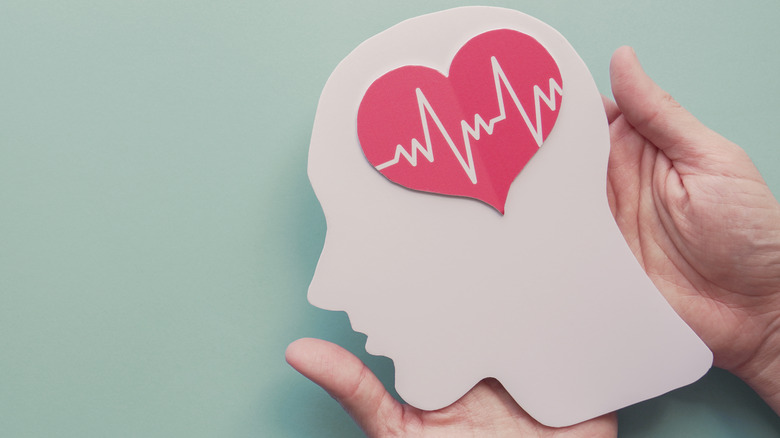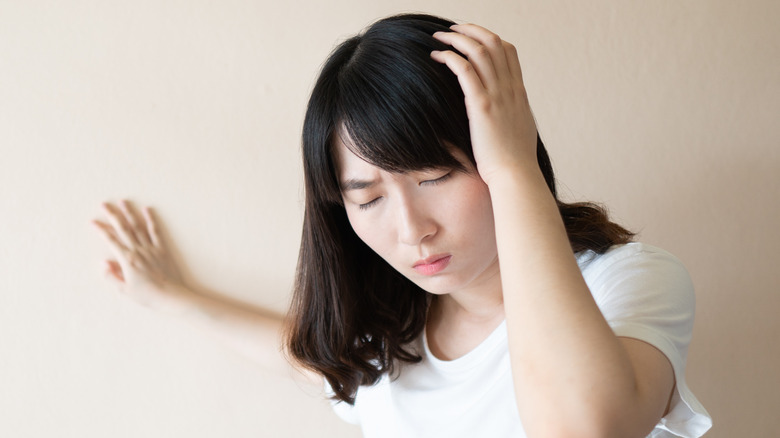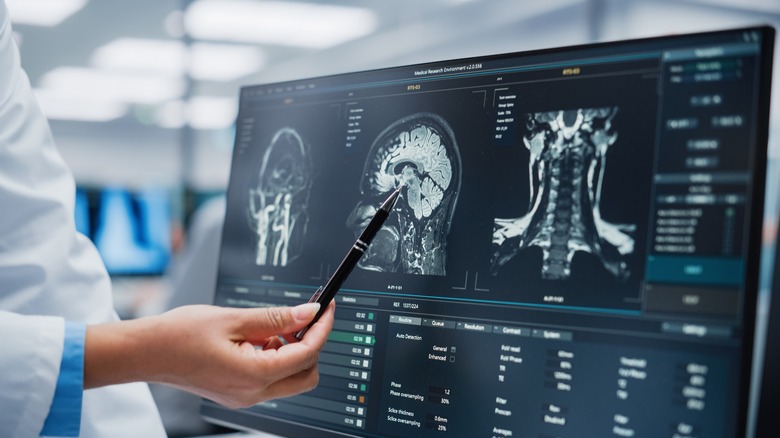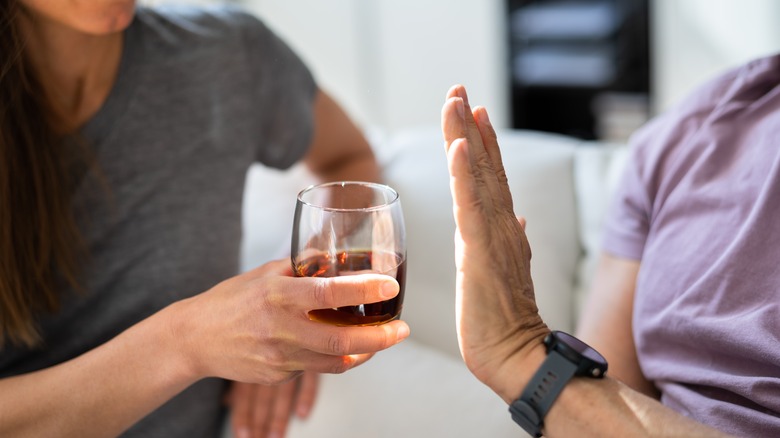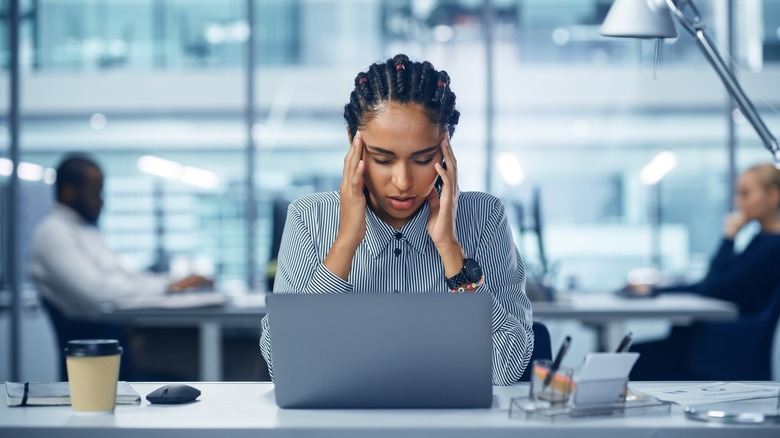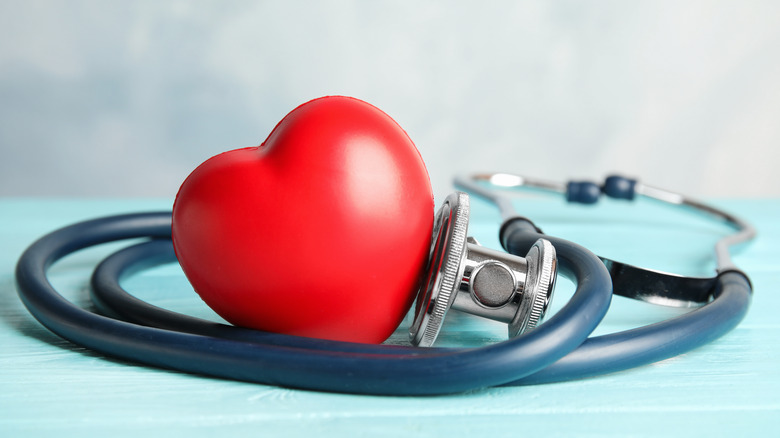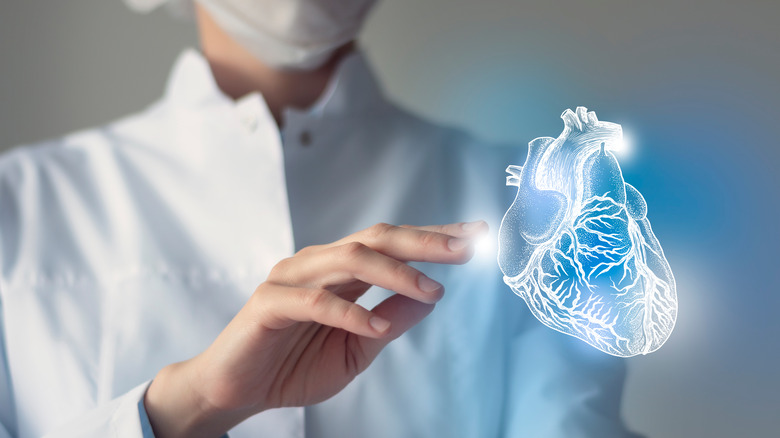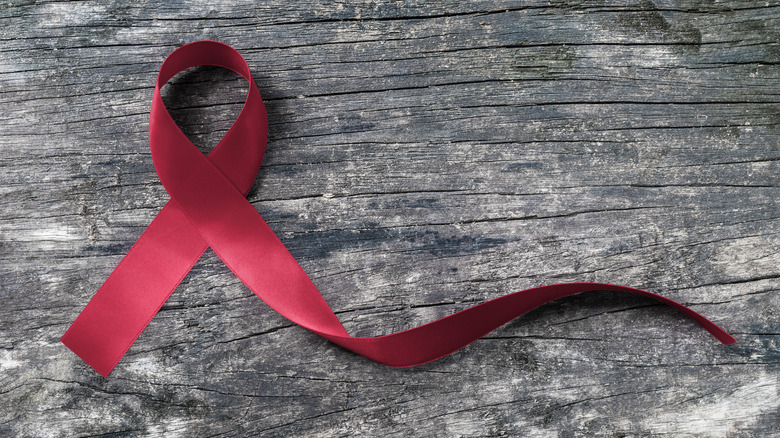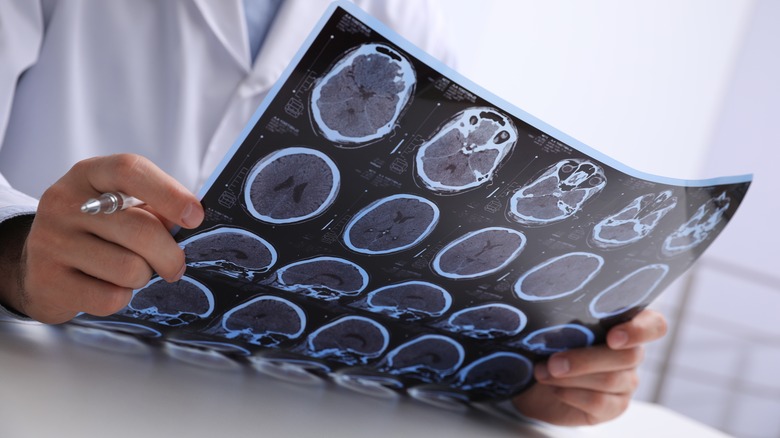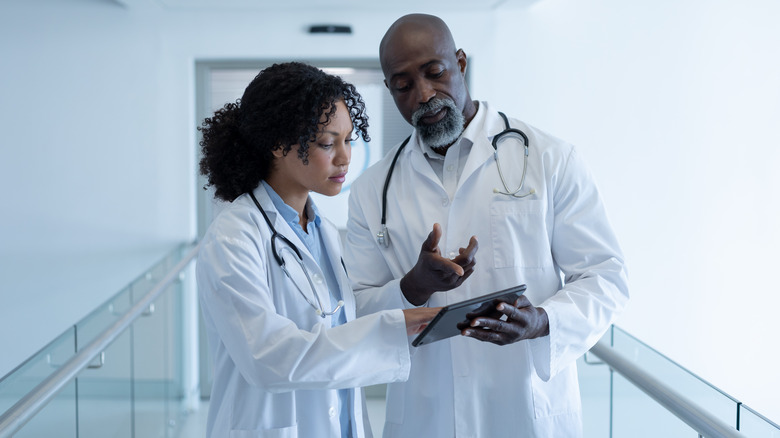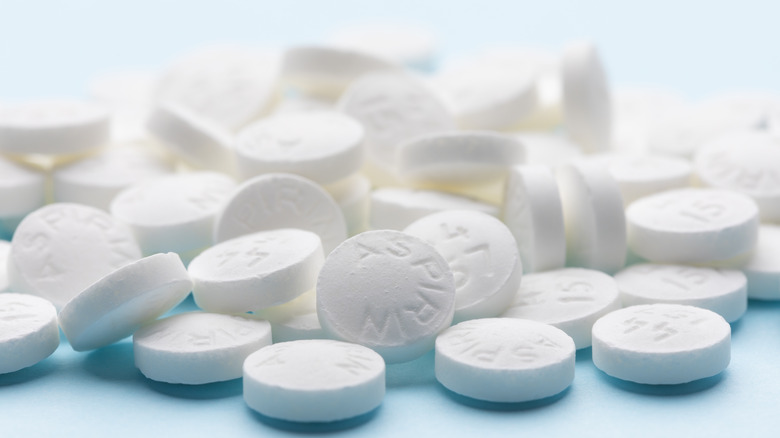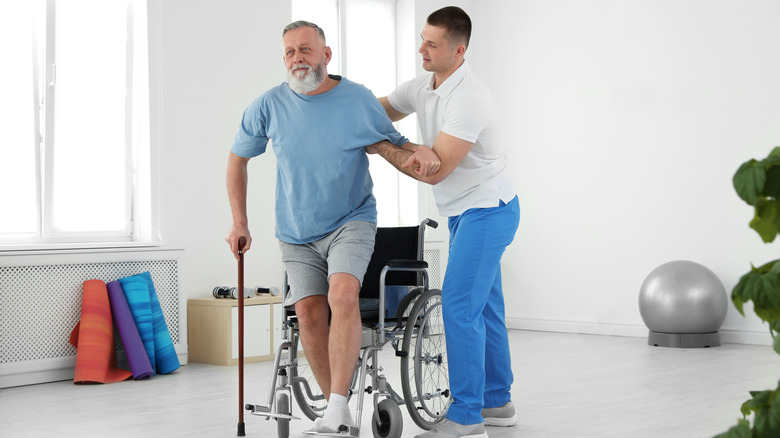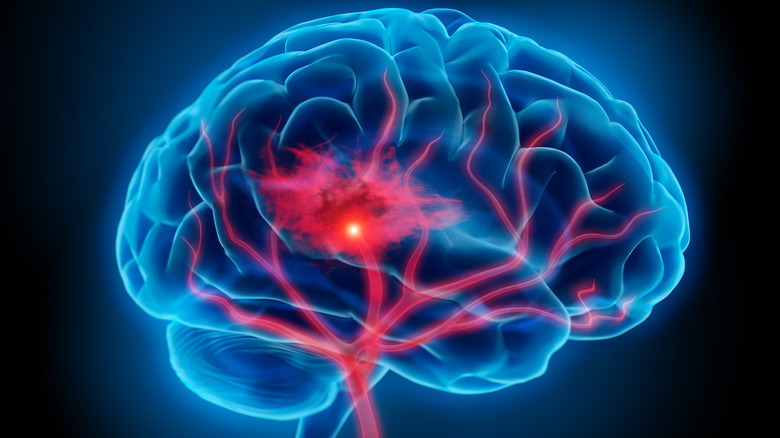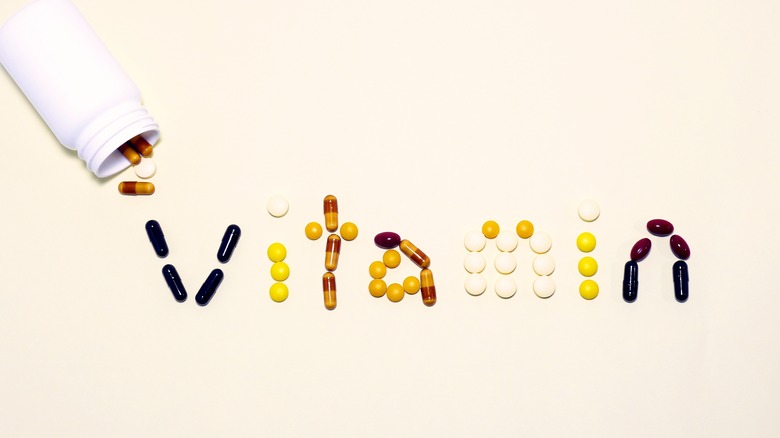Myths You Should Stop Believing About Strokes
High blood pressure can lead to a range of health complications, but few are as dangerous or as common as a stroke. According to the World Stroke Organization, around a quarter of all people will have a stroke at some point in their lives. Almost 800,000 individuals experience a stroke in the United States annually, and approximately 137,000 of these medical emergencies are fatal, per the Eunice Kennedy Shriver National Institute of Child Health and Human Development.
While the likelihood of having a stroke — caused by a blood clot or hemorrhage in the brain, leading to further health complications — can often be identified through markers of health, the onset can often appear to be out of the blue. And perhaps as a result of this, despite their highly common nature, strokes can still be difficult to understand for a lot of people. This can lead to myths and misinformation circulating about the life-threatening condition. It's vital, though, that you know the facts from the fiction. Let's take a look at the top myths surrounding strokes, and establish what's true and what's not.
Myth: You can't have a stroke if you're young
Strokes are commonly associated with older adults, however the majority of these serious medical events are actually experienced by individuals between the ages of 50 and 70 (via the World Stroke Organization). Therefore, it is a myth that you're not at risk if you're young. Strokes actually occur in 10% to 15% of people between the ages of 18 and 45 annually, with case rates for young adults seeing a huge rise in recent years in the United States, per the American Heart Association.
The likelihood of strokes occurring in younger people can be made even higher as a result of binge-drinking regularly, an increased susceptibility to migraines, living a less active lifestyle, and having sickle cell disease (via UNM Health). Almost a third of American adults have one of the top risk factors for stroke, including hypertension, high cholesterol, diabetes, smoking, and obesity.
According to a study published in Stroke, the journal of the American Stroke Association, 30% of adults under age 45 aren't aware of the early warning signs. Facial or limb numbness, loss of balance, dizziness, difficulty speaking, limited vision, vision disturbance, a painful headache, and confusion are all indicators that you could be having a stroke. "Time is critical for treating stroke. The earlier people recognize symptoms, the better their chances are to reduce long-term disability from stroke," says author Khurram Nasir, M.D., M.P.H., M.Sc., division chief at Houston Methodist DeBakey Heart and Vascular Center.
Myth: Strokes are all the same
It's easy to assume that a stroke is one condition that just happens to affect a lot of people. And while the latter is certainly true, strokes fall into three distinct types, all of which occur in slightly different ways.
According to the American Stroke Association, the most frequent form is an ischemic stroke. These medical events happen when your blood is blocked from getting to and from your brain, often by a blood clot. Transient ischemic attacks (also known as TIAs) are similar to ischemic strokes, except the blood is only temporarily blocked. It's for this reason that they're also known as mini-strokes, with symptoms that are generally less severe and last for a shorter amount of time. The third type, hemorrhagic stroke, happens when a blood vessel bursts in your brain that causes bleeding. While these types of strokes are more unlikely, they also tend to be more dangerous and potentially fatal (via Michigan Health). All strokes have the potential to cause enormous health consequences, so speedy treatment is crucial to successful recovery.
Myth: Strokes are unpreventable
The onset of a stroke can be rapid, so it's often assumed that no matter what you do, if you're going to have a stroke you can't stop it. And while this may be true at the point of a stroke actually happening, it's not strictly true that you can't reduce your likelihood of having a stroke in the first place.
According to Harvard Health Publishing, keeping an eye on your blood pressure should be one of your top priorities in prevention. The higher your blood pressure, the higher your likelihood of having a stroke. To decrease your chances of stroke, you can adapt your lifestyle to consume less salt, more fruits and vegetables, being more active, and quitting smoking. Alcohol consumption can also contribute to having a stroke, so if you drink more than one serving per day it might be worth thinking about cutting down. It's also important to treat other health conditions to reduce stroke risk. Untreated atrial fibrillation — which causes an irregular heartbeat — and uncontrolled diabetes can both increase blood clots, and the chance of having a stroke.
Myth: Strokes are highly painful
A stroke is often associated with the image of a person clutching their head in pain. But the assumption that all of these medical events cause a splitting headache is not entirely true. "Pain is not a common symptom of stroke," explains OSF HealthCare Saint Anthony Medical Center vascular neurologist Monica Simionescu, M.D. (via OSF HealthCare). Although pain can occur in rarer hemorrhagic strokes, which are triggered due to bleeding in the brain, strokes usually don't cause headaches beforehand.
Experiencing pain in your head may be common after experiencing a stroke, and can often be prompted by medication that you're taking, dehydration, stress, or migraines, per Stroke Association. If you have persistent headaches after having a stroke, it's a wise idea to get in touch with your doctor to discuss why this could be the case. When a stroke is happening it is key to keep an eye out for the more telling signs of the condition, like facial drooping or slurred speech. If you notice these symptoms it is important to seek immediate medical attention.
Myth: Symptoms are hard to spot
Strokes are often seen as elusive. Because the signs aren't as immediate as a broken leg, for instance, there's a misconception that it's tricky to figure out whether someone's having a stroke in the first place. But stroke symptoms are easily identifiable, and it's helpful for pretty much everyone to know them given their frequency.
The easiest way to remember the signs of a stroke is with the F.A.S.T. method, per the American Stroke Association. The F.A.S.T. acronym helps you identify the key symptoms — face drooping, arm weakness, speech difficulty — and when it is time to call 911. A good way to see whether part of the face is drooping or has lost its mobility, is to ask someone to smile and see if it's uneven. Arm weakness is characterized by someone being unable to raise their arms above their head, or a loss of feeling. You should be able to identify if someone is experiencing speech difficulty if they are slurring their words, or if they have a difficult time saying a simple sentence back to you. If you observe these symptoms, it is time to call 911 — this is vital, as strokes need to be treated urgently. Be clear with the 911 operator about the symptoms you've observed, and how long they've been present.
Myth: Mini-strokes aren't that dangerous
Of the three different types of strokes, one of them doesn't seem as bad. But transient ischemic attacks (TIA), also known as "mini-strokes," are perhaps misrepresented by their name. "Because of what the term implies, everybody thinks it's just a tiny stroke. The truth is, the symptoms can be pretty severe," states Harvard Medical School associate professor of neurology Natalia Rost, M.D. (via Harvard Health Publishing).
Mini-strokes happen in the same way that a regular ischemic stroke does, due to a blood clot that disrupts blood flow to and from the brain. In the case of TIA, however, symptoms tend to pass quicker, as the blood can continue flowing again. The problem is, that is often not the end of the story — having a mini-stroke can be a clear precursor to having a full stroke, and a large proportion of people who experience TIAs will then have a full-scale ischemic stroke within 12 months if left untreated. It is important to not ignore any symptoms that you have, however small they are. "If you're having stroke symptoms, you should act on them immediately. Do not wait to see if they'll go away," says Rost. Following a mini-stroke, you must follow any advice from your doctor about lifestyle adjustments to reduce your chances of having further issues.
Myth: A stroke is basically a heart attack
As strokes are often connected with blood pressure and happen without warning, it's no huge leap of logic to think that they're just like a heart attack. But in fact, the two are pretty distinct and should be treated as such. A stroke occurs not in your heart, but in your brain, and is caused by impeded blood flow or a brain hemorrhage, per Tri-City Medical Center. On the other hand, heart attacks happen when blood is unable to reach the heart properly, making it work harder, and eventually sustain damage or stop working.
The symptoms of the two conditions are also different. Stroke symptoms are usually centered around numbness in the limbs, or facial muscles, and difficulty speaking. Meanwhile, heart attacks generally prompt chest pain, difficulty breathing, pain radiating through the upper limbs and back, and loss of consciousness. While they are different, they're alike in two very important ways. The first is that they're both medical emergencies, and require treatment immediately. The second is that their likelihood can be lowered through lifestyle changes like stopping smoking, trying to reduce stress, and being more active.
Myth: Strokes are only caused by lifestyle factors
It's very tempting to think that strokes are caused by lifestyle alone. After all, we're constantly told that normal blood pressure is something to strive for, and the way to get there is by living differently.
That's definitely not untrue, but it's false to assume that if you have a stroke it's solely because of how you live. Genetics can increase the risk of having a stroke, including being prone to high blood pressure or cardiovascular disease (via Medical News Today). Individuals who have sickle cell disease and single-gene conditions are also more likely to have a stroke, as blood clots can form due to the shape of the red blood cells, per Stroke Association. It's also worth bearing in mind that you may have a family history of strokes, which can also increase your risk, (via the CDC). If you have any concerns about stroke risk, talk to your doctor about how you can reduce the impact of a genetic predisposition through lifestyle changes.
Myth: Strokes can't be treated
One of the biggest myths circulating about strokes is that if you have one, there's not a lot you can do. We can understand why people would think that — after all, strokes come on suddenly, so they could seem hard to treat. But there are distinct pathways for the types of strokes that people have, and provided that they can get to the hospital fast enough, doctors may be able to address the condition and start treatment immediately, per the Mayo Clinic.
For ischemic strokes, the emphasis is on getting blood back to the brain as soon as possible, which may be done through an endovascular procedure. This is done by potentially removing the blood clot with a stent retriever, or by delivering medicine that dissolves the blood clot. Hemorrhagic stroke treatment will try to bring down the bleeding in the brain, by administering medication, surgery, or using radiotherapy. Mini-strokes can (and should) also be treated, with the focus on preventing the risk of a further stroke by making more space in potentially narrow arteries. Following the initial emergency procedures, treatment will continue with the focus on rehabilitation and restoring everyday life as much as possible.
Myth: You'll be able to tell if you have a stroke
With the large number of people who experience a stroke in their lifetimes, it's wild to think that these medical events can go unnoticed. But one of the biggest myths out there is that all strokes are easy to spot, per Medical News Today. Silent strokes, which don't cause any visible symptoms at all, are pretty common. According to research published in Cerebrovascular Diseases, there could be almost 11 million silent strokes every year. The number of symptomatic strokes is much smaller. Silent strokes present a pretty significant problem since you can't notice them, but they can still have an impact on your brain function, (via WebMD).
The only way that you'll know if you've had a silent stroke is by getting a brain scan, which will indicate that damage has occurred. Your doctor may also be able to diagnose a silent stroke through symptoms like minor cognitive difficulty, or mobility issues. While brain damage from silent strokes may be irreversible, it's still possible to treat the effects of one by stimulating other areas of your brain.
Myth: Taking aspirin will prevent or treat a stroke
Aspirin is often cited as a wonder drug when it comes to stroke, and if you have a bottle stashed in your medicine cupboard you might be tempted to start taking it daily to reduce your risk. But this myth needs to be well and truly put to bed, folks. The reason why aspirin is thought to help lower the risk of stroke is that it thins the blood, and thereby reduces your likelihood of having blood clots, per the American Stroke Association. However, it's highly unwise to start on a course of aspirin without consulting your doctor, regardless of these effects. Daily aspirin can cause a range of other problems, like stomach bleeding, that may outweigh the benefits of taking it every day.
But, Aspirin has been observed to be very useful in treating mini-strokes. Research published in The Lancet found that aspirin therapy immediately after a mini-stroke had beneficial effects, significantly reducing the likelihood of having a full stroke. It is important to always consult your doctor before taking aspirin for this reason, or because you think it might prevent strokes entirely — never self-prescribe.
Myth: You can't recover from a stroke
Strokes are serious conditions and recovery from them can be challenging, but it is possible. How people recover from a stroke is different from case to case. One person could have a full recovery very quickly, while it could take months or years for another to improve, per the CDC. After initial treatment, stroke recovery focuses on rehabilitation with a range of health specialists who will help individuals regain their mobility and their speech faculty. Occupational therapists may also work with people who have had a stroke to assist them in managing their day-to-day activities.
Post-stroke care can also treat associated mental health challenges that come with the condition, and individuals who experience depression may be prescribed therapy or medication. The outcomes vary, with some folks returning to their normal lives without any problems, and others facing larger challenges. Long-term complications may occur, both with cognitive and physical function. Remember to follow your treatment plan carefully, and to reach out to family and friends for support.
Myth: Strokes always cause paralysis
A stroke can have profound long-term effects on the health of your brain specifically, and this can lead to paralysis (via Medical News Today). However, a common misconception is that this is always the case.
According to research published in Circulation, many older stroke patients experience mobility issues, while others will be left with no lasting impact on their physical health, and some people will experience other long-term changes. How people are affected by a stroke long-term is often determined by where it happened in the brain. Difficulties surrounding speech, issues with memory, and behavioral alterations can occur when the stroke impacts the left side of the brain, per the American Stroke Association. For strokes in the brain's right side, vision changes can be more common, as well as behavioral changes that make a person more inquisitive or have a faster internal tempo. It's interesting to note, too, that each side of the brain controls the opposite side of the body. So people who have a stroke on the left-hand side might have changes in their body's right side.
Myth: You can prevent a stroke by taking vitamins
Getting the right amount and balance of vitamins is important for an enormous range of reasons, from assisting in drawing nutrients from the food you eat to keeping infections at bay, per National Institute on Aging. But what vitamins probably won't do is stop you from getting a stroke.
"At this point in time, there's no data to support that taking vitamins can prevent a stroke from happening," says UMass Chan Medical School assistant professor of neurology Rajiv Padmanabhan, M.D. (via Baystate Health). The reason why this myth seems to have been perpetuated is that people who have higher levels of homocysteine (an amino acid) in their blood tend to be more likely to have strokes, according to research published in the Stroke journal. Certain B vitamins can work to reduce homocysteine levels — and so naturally people then assumed that if you took more of these vitamins, your stroke risk would be lower. "However, the research just doesn't bear it out," says Padmanabhan. Instead, it's best to focus on reducing stroke risk by living a healthy lifestyle and eating a varied, nutritious diet that's high in all of the vitamins and minerals you need.

